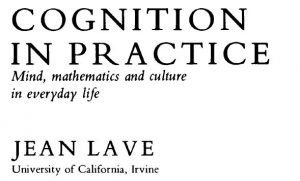Théories et pratiques de l’apprentissage situé 41/101

Cognition in Practice (23/n)

Introduction
Dans cette dernière section du chapitre 7 de son livre Cognition in Practice, Jean Lave nous livre ses conclusions provisoires et annonce le contenu du chapitre suivant
Conclusions
D’une part, il est difficile de détecter les problèmes à résoudre dans la vie quotidienne et, … d’autre part, il apparaît que les « champs d’action » permettent et sont reproduits par l’activité courante.
[…]
Bien que la » résolution de problèmes » soit un concept clé de la théorie cognitive, les preuves rassemblées dans ce chapitre et dans les chapitres précédents permettent de conclure qu’elle n’a pas un rôle aussi large et fécond à jouer dans l’analyse de l’activité quotidienne dans son environnement habituel.
On the one hand. in the description of everyday practice it is difficult to detect problems to be solved or conventional scholastic problem solving activity (e.g. encapsulated, procedure-driven interruptions that stop and restructure ongoing activity into arithmetic forms). On the other, it appears that fields for action – stashes, measuring devices, the process of choosing each grocery item – enable and are reproduced by ongoing activity, generatively and variously structured from among the obvious and often routinely available resources of persons’ concerns, settings and activities.
Though « problem solving » is a key concept in cognitive theory, the evidence assembled in this and previous chapters provides grounds for the conclusion that it does not have a correspondingly broad and fecund role to play in the analysis of everyday activity in its customary settings.
Comment, alors, concevoir ce que l’on pourrait mieux appeler la transformation des relations quantitatives ? La réponse ici est nécessairement brève, mais elle sera reprise dans le chapitre suivant. L’accent est mis sur les relations entre les domaines d’action et le processus de gestion des problèmes, illustré par un autre exemple de l’étude Weight Watchers.
« How, then, are we to conceive of what might better be termed the transformation of quantitative relations? The response here is necessarily brief, but will be taken up again in the following chapter. The focus is on relations between fields for action and the process of problem management, illustrated by one further example from the Weight Watchers study. »
Un dernier exemple tiré de l’étude sur les Weight Watchers, où l’on demande à chaque personne de préparer un déjeuner composé de deux sandwiches… pour constater qu’il avait 9 modèles / processus différents
« At one point early in that study each dieter was asked to prepare a lunch of two open-faced sandwiches, one cheese and one peanut butter for the extended analysis, see de la Rocha 1986, chapter 6). Each of the nine began by getting out a plate and laying two slices of bread on it. This had several effects simultaneously. It was a means of appropriating the problem, and at the same time created a field for action and a resolution shape to the problem.
It is plausible to suppose that they had to recognize that something was problematic, represent it, implement a resolution, and evaluate the results. It is not impossible to point to aspects of the dieters’ activity that fit each of these analytic categories of problem-solving action. But in general these occurred in no determinate sequence and in fact, nine different patterns were found. »
De plus, un seul mouvement (move) implémentait plusieurs catégories d’action en même temps.
« Some move often implemented several categories of action at once. Once enabled, sandwich making (and calculations about proper amounts of cheese and peanut butter) unfolded in an undetermined way, making use of many possible resources for structuring action, taking certain elements as incorrigible for immediate purposes, creating a specific articulation between the dieting and cooking worlds converging in and through activity in setting. »
Les processus de gestion de problèmes comme ceux-ci sont dialectiques (…) un calcul qui donne la solution (mathématique) va générer un nouveau dilemme…
Calculational episodes cannot be classified as constant members of either category. A continuation of the peanut butter and wich exercise illustrates the point. Initially some of the dieters engaged with a calculational dilemma concerning how to follow the diet rules while making a peanut butter sandwich. But this generated a new dilemma: In making the sandwiches the dieters discovered that the formal solution called for an extraordinary amount of peanut butter. As the dieters realized this they exclaimed about it with vehemence, and scraped off the excess with alacrity (though knowing that the quantity on the bread was an accurate solution to the calculational problem). The calculation became simply the solution to a puzzle, while the peanut was a true dilemma. There were other snags involving math in the observational data on the Weight Watchers that evoked strong feelings, but more of them were limited in affect and action, « Let’s see, I’ll need twice as many tomatoes in the salad since David and Brian are coming to dinner. » That is, math is sometimes a dilemma, but it is also the case that calculation is often unproblematic. It as often generates dilemmas as resolves them.
Et l’auteur de conclure que la résolution de problème dans les études cognitive est à la fois exagéré et appauvri…
« This suggests that conventional assumptions about the importance attributed to « problem solving » in cognitive studies is both exaggerated and impoverished. «
Et en même temps cela indique l’importance de prendre en considération à quel point les relations quantitatives posent problèmes si l’on souhaite comprendre l’activité courante.
At the same time it indicates the importance of considering whether and how quantitative relations are problematic if we wish to understand ongoing activity.
Dans chapitre et dans les chapitres précédents il a été question des activités structurantes … et l’auteur a soutenu la position suivante: la structuration de l’activité courante réflète, soutient, produit et aide à la reproduction du caractère routinier de l’activité quotidienne.
« This and the previous chapter have discussed structuring resources and the transformation of the structuring of activity in relation with different activities. I have argued that at one and the same time the structuring of ongoing activity reflects and supports, produces, and helps to reproduce the routine character of everyday activity. »
Jean Lave pose la question : Quelle est la nature de ces connexions multiples et variées, pour répondre ... les relations entre ces activités semblent les constituer mutuellement. En d’autres termes, la structure complexe de l’activité en cours (dont la transformation des relations quantitatives). est une partie) est générée dans leur articulation dialectique.
What is the nature of these multiple and varied connections? The question becomes more insistent as the multiplicity of ties embodied in activity and the articulation of structuring resources takes a more central role in the argument. Certain plausible responses may be eliminated. Alternative structuring resources are not independent of each other, such that the implementation of one excludes others from consideration, without changing any of them in the process. On the contrary, I have emphasized the ways in which activities structure each other differently on different occasions. They proceed at the same time, given shape by their mutual articulation. Further, structuring resources for different activities are not causally dependent on one another. For example, knitting and reading, or grocery shopping and arithmetic calculation, each can go forward without the other, though organized differently when articulated differently with other activities. Relations between such activities appear to mutually constitute them. That is, the complex structure of ongoing activity (of which the transformation of quantitative relations is a part) is generated in their dialectical articulation.
Pour conclure
Le concept de relations dialectiques nécessite une élaboration, et doit être étendu aux questions de relations entre l’activité et son cadre. …
Une question n’a pas encore été abordée, à savoir pourquoi la spécificité de l’activité est ancrée dans des cadres (settings), et pour ce faire, les cadres (settings) doivent eux-mêmes être traités en tant qu’objets d’analyse. Ce qui sera fait dans le prochain chapitre, dans une analyse de la constitution dialectique de l’arithmétique. au supermarché.
The concept of dialectical relations requires elaboration, and must be extended to questions of relations between activity and its settings. This, in turn, presupposes a discussion of settings in their own right. For while much of the discussion has been about the multiple relations that give situationally-specifIc activity its shape as persons act, we have not yet addressed the question of why this specificity of activity is anchored within settings. To do so the setting, too, must be treated as an analytic object. The two questions will be considered together in the next chapter, in an analysis of the dialectical constitution of arithmetic practice in the supermarket.
Billets précédents
Billet 1: Définitions de l’apprentissage situé
Billet 2: Pourquoi s’intéresser à la théorie de l’apprentissage situé?
Billet 3: Démarche et retour aux sources
Billet 4: Mai 1968 et l’apprentissage situé
Billet 5: Apprentissage situé et conversation
Billet 6: Lucy Suchman, mon téléphone portable et moi
Billet 7: Conversations avec moi-même (n° 1)
Billet 8: L’apprentissage situé mis en pratique, cela ferait quoi?
Billet 9: Contribution de la psychologie soviétique à la théorie de l’apprentissage situé
Billet 10: Les apports de la philosophie à la théorie de l’apprentissage situé
Billet 11: Focus sur l’école Dewey
Billet 12: Apports de la psychologie de la perception – la notion d’affordance
Billet 13: Apprentissage situé et intelligence artificielle, deep learning, réalité virtuelle, réalité augmentée, etc…
Billet 14: Conversations avec moi-même (N°2)
Billet 15: Quand John Dewey rencontre Jean Lave
Billet 16: Cognition in Practice (1/n)
Billet 17: Cognition in Practice (2/n)
Billet 18: Cognition in Practice (3/n)
Billet 19: Cognition in Practice (4/n)
Billet 20 : Cognition in Practice (5/n)
Billet 21: « Conversations avec moi même N°3 »
Billet 22: Cognition in Practice (6/n)
Billet 23: Cognition in Practice (7/n)
Billet 24: Cognition in Practice (8/n)
Billet 25: Cognition in Practice (9/n)
Billet 26: Cognition in Practice (10/n)
Billet 27: Cognition in Practice (11/n)
Billet 28: « Conversations avec moi-même N°4 »
Billet 29: Cognition in Practice (12/n)
Billet 30: Cognition in Practice (13/n)
Billet 31: Cognition in Practice (14/n)
Billet 32: Cognition in Practice (15/n)
Billet 33: Cognition in Practice (16/n)
Billet 34: Cognition in Practice (17/n)
Billet 35: « Conversations avec moi-même N°5 »
Billet 36: Cognition in Practice (18/n)
Billet 37: Cognition in Practice (19/n)
Billet 38: Cognition in Practice (20/n)
Billet 39: Cognition in Practice (21/n)
Billet 40: Cognition in Practice (22/n)
Related Posts
4 livres d’un seul coup, ou seulement 1
Le journal d’un WOLer 5/n
Théories et Pratiques de l’apprentissage situé (49/101)
Articles récents
Archives
- juin 2025
- mars 2025
- novembre 2024
- octobre 2024
- août 2024
- mai 2024
- mars 2024
- janvier 2024
- décembre 2023
- septembre 2023
- juin 2023
- avril 2023
- mars 2023
- janvier 2023
- octobre 2022
- septembre 2022
- juillet 2022
- mai 2022
- avril 2022
- mars 2022
- février 2022
- janvier 2022
- octobre 2021
- août 2021
- juillet 2021
- mai 2021
- février 2021
- juin 2020
- mai 2020
- avril 2020
- février 2020
- janvier 2020
- décembre 2019
- novembre 2019
- octobre 2019
- septembre 2019
- août 2019
- juillet 2019
- mai 2019
- avril 2019
- mars 2019
- février 2019
- janvier 2019
- décembre 2018
- septembre 2018
- août 2018
- juillet 2018
- juin 2018
- mai 2018
- avril 2018
- mars 2018
- février 2018
- janvier 2018
- décembre 2017
- novembre 2017
- octobre 2017
- septembre 2017
- août 2017
- juin 2017
- mai 2017
- avril 2017
- mars 2017
- février 2017
- janvier 2017
Catégories
- Actualités
- Adaptive Learning
- Allemagne
- Apprendre
- Apprentissage
- Branding
- Business
- Coaching
- Codeveloppement
- Communautés de pratique
- Deep learning
- Design
- Development
- E-Learning
- Ecole
- écologie
- Education
- Europe
- Formation
- Histoire
- IA
- Intelligence articificielle
- LBC
- metacognition
- Non classé
- Orientation
- orientation
- Philosophie
- Poésie
- Réalité Augmentée
- Réalité Virtuelle
- Transition digitale
- WOL





Commentaires récents